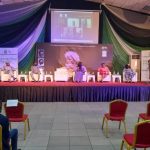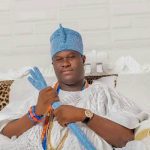The Wole Soyinka Centre for Investigative Journalism is asking media organisations across Nigeria to prioritise balanced representation of women in news reportage and management.
Executive Director for the Centre, Motunrayo Alaka said this while presenting a report on ‘Who leads the newsrooms and news in Nigeria.
A recent report from the Wole Soyinka Center for investigative journalism (WSCIJ) has revealed that there are significant disparities in gender representation in Nigerian newsrooms. Titled ‘who leads the newsroom and the news’, the report highlights a huge gender gap between men and women in news management and the need to build the capacity of news media organisations.
According to the survey, one in four persons in the leadership of the newsrooms and news are women, with only 26.9% of management positions and 24.2% board roles occupied by women.
Just like the media, the national assembly which is the highest law making entity in Nigeria reflects the female underrepresentation, out of 109 senators, 3 are females while the house of representatives has 17 females from 360 seats.
The Wole Soyinka Centre for Investigative Journalism is asking media organisations across Nigeria to prioritise balanced representation of women in news reportage and management.
Executive Director for the Centre, Motunrayo Alaka said this while presenting a report on ‘Who leads the newsrooms and news in Nigeria.
A recent report from the Wole Soyinka Center for investigative journalism (WSCIJ) has revealed that there are significant disparities in gender representation in Nigerian newsrooms. Titled ‘who leads the newsroom and the news’, the report highlights a huge gender gap between men and women in news management and the need to build the capacity of news media organisations.
According to the survey, one in four persons in the leadership of the newsrooms and news are women, with only 26.9% of management positions and 24.2% board roles occupied by women.
Just like the media, the national assembly which is the highest law making entity in Nigeria reflects the female underrepresentation, out of 109 senators, 3 are females while the house of representatives has 17 females from 360 seats.
The Wole Soyinka Centre for Investigative Journalism is asking media organisations across Nigeria to prioritise balanced representation of women in news reportage and management.
Executive Director for the Centre, Motunrayo Alaka said this while presenting a report on ‘Who leads the newsrooms and news in Nigeria.
A recent report from the Wole Soyinka Center for investigative journalism (WSCIJ) has revealed that there are significant disparities in gender representation in Nigerian newsrooms. Titled ‘who leads the newsroom and the news’, the report highlights a huge gender gap between men and women in news management and the need to build the capacity of news media organisations.
According to the survey, one in four persons in the leadership of the newsrooms and news are women, with only 26.9% of management positions and 24.2% board roles occupied by women.
Just like the media, the national assembly which is the highest law making entity in Nigeria reflects the female underrepresentation, out of 109 senators, 3 are females while the house of representatives has 17 females from 360 seats.
The Wole Soyinka Centre for Investigative Journalism is asking media organisations across Nigeria to prioritise balanced representation of women in news reportage and management.
Executive Director for the Centre, Motunrayo Alaka said this while presenting a report on ‘Who leads the newsrooms and news in Nigeria.
A recent report from the Wole Soyinka Center for investigative journalism (WSCIJ) has revealed that there are significant disparities in gender representation in Nigerian newsrooms. Titled ‘who leads the newsroom and the news’, the report highlights a huge gender gap between men and women in news management and the need to build the capacity of news media organisations.
According to the survey, one in four persons in the leadership of the newsrooms and news are women, with only 26.9% of management positions and 24.2% board roles occupied by women.
Just like the media, the national assembly which is the highest law making entity in Nigeria reflects the female underrepresentation, out of 109 senators, 3 are females while the house of representatives has 17 females from 360 seats.
The Wole Soyinka Centre for Investigative Journalism is asking media organisations across Nigeria to prioritise balanced representation of women in news reportage and management.
Executive Director for the Centre, Motunrayo Alaka said this while presenting a report on ‘Who leads the newsrooms and news in Nigeria.
A recent report from the Wole Soyinka Center for investigative journalism (WSCIJ) has revealed that there are significant disparities in gender representation in Nigerian newsrooms. Titled ‘who leads the newsroom and the news’, the report highlights a huge gender gap between men and women in news management and the need to build the capacity of news media organisations.
According to the survey, one in four persons in the leadership of the newsrooms and news are women, with only 26.9% of management positions and 24.2% board roles occupied by women.
Just like the media, the national assembly which is the highest law making entity in Nigeria reflects the female underrepresentation, out of 109 senators, 3 are females while the house of representatives has 17 females from 360 seats.
The Wole Soyinka Centre for Investigative Journalism is asking media organisations across Nigeria to prioritise balanced representation of women in news reportage and management.
Executive Director for the Centre, Motunrayo Alaka said this while presenting a report on ‘Who leads the newsrooms and news in Nigeria.
A recent report from the Wole Soyinka Center for investigative journalism (WSCIJ) has revealed that there are significant disparities in gender representation in Nigerian newsrooms. Titled ‘who leads the newsroom and the news’, the report highlights a huge gender gap between men and women in news management and the need to build the capacity of news media organisations.
According to the survey, one in four persons in the leadership of the newsrooms and news are women, with only 26.9% of management positions and 24.2% board roles occupied by women.
Just like the media, the national assembly which is the highest law making entity in Nigeria reflects the female underrepresentation, out of 109 senators, 3 are females while the house of representatives has 17 females from 360 seats.
The Wole Soyinka Centre for Investigative Journalism is asking media organisations across Nigeria to prioritise balanced representation of women in news reportage and management.
Executive Director for the Centre, Motunrayo Alaka said this while presenting a report on ‘Who leads the newsrooms and news in Nigeria.
A recent report from the Wole Soyinka Center for investigative journalism (WSCIJ) has revealed that there are significant disparities in gender representation in Nigerian newsrooms. Titled ‘who leads the newsroom and the news’, the report highlights a huge gender gap between men and women in news management and the need to build the capacity of news media organisations.
According to the survey, one in four persons in the leadership of the newsrooms and news are women, with only 26.9% of management positions and 24.2% board roles occupied by women.
Just like the media, the national assembly which is the highest law making entity in Nigeria reflects the female underrepresentation, out of 109 senators, 3 are females while the house of representatives has 17 females from 360 seats.
The Wole Soyinka Centre for Investigative Journalism is asking media organisations across Nigeria to prioritise balanced representation of women in news reportage and management.
Executive Director for the Centre, Motunrayo Alaka said this while presenting a report on ‘Who leads the newsrooms and news in Nigeria.
A recent report from the Wole Soyinka Center for investigative journalism (WSCIJ) has revealed that there are significant disparities in gender representation in Nigerian newsrooms. Titled ‘who leads the newsroom and the news’, the report highlights a huge gender gap between men and women in news management and the need to build the capacity of news media organisations.
According to the survey, one in four persons in the leadership of the newsrooms and news are women, with only 26.9% of management positions and 24.2% board roles occupied by women.
Just like the media, the national assembly which is the highest law making entity in Nigeria reflects the female underrepresentation, out of 109 senators, 3 are females while the house of representatives has 17 females from 360 seats.














